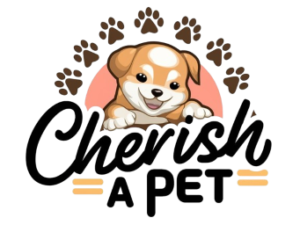Originating in Belgium, Flemish Giant rabbits are among the largest breeds of rabbits worldwide. The Flemish giant rabbits are frequently called the “gentle giants” of the rabbit world because of their remarkable size and kind disposition.
The Flemish Giant is native to Flanders, a region in northern Belgium. It is an ancestor of many rabbit breeds, including the Belgium Hare. It was imported from England and Belgium to America in 1890.

Flemish giant rabbit was recognized by ARBA in 1910 and then promoted by the National Federation of Flemish Giant Rabbit Breeders(NFFGRB), which was formed in 1915. Large, powerful, and endearing, Flemish Giants are a remarkable addition to any home. In addition to being common pets, they are also raised for meat and fur.
Physical Appearance, Size, and Life Expectancy
One of the largest domestic rabbit varieties is the Flemish Giant, which can grow to a maximum length of 2.5 feet and a usual weight of 15 to 22 pounds (6.8 kg to 22 kg).
Their huge, broad, muscular frame is complemented by a wide, deep chest and a semi-arched back. Large, upright ears that are 5 to 8 inches long are featured on their head, which is broad and rounded in proportion to their body.
They have a life expectancy of around 8–10 years.
The Flemish Giant has rich, glossy fur that is colored in a variety of hues, such as blue, fawn, black, light gray, sandy, steel gray, and white. In 1916, the only colors recognized were light gray, steel, or black. In 1919, blues and whites were authorized, then in 1924, sandy-shaded variants, and in 1938, fawns were recognized.

The ARBA does not recognize the broken colors. Depending on the color of their coat, they have big, expressive eyes that are colored red, blue, or brown. They can jump well because of their strong, robust legs, especially their muscular hind legs.
Behavior and Temperament
Giant Flemish rabbits are renowned for having a calm and amiable disposition. They are great pets for families with young children since they are usually gentle and calm. They can develop close relationships with their owners and love social engagement. But because of their size, they must be handled cautiously to prevent damage.
The Flemish Giants are social and are comfortable with other companions. They love to enjoy a peaceful life. You may find your giant bunny taking a nap frequently. These are not-so-active breeds of domestic rabbits.
Though they have a friendly temperament, they can bite or scratch if handled roughly.
Male and Female Flemish Giant Rabbits
When choosing a Flemish Giant rabbit, it’s important to understand the differences between males and females. Male rabbits, known as bucks, are generally larger than females (does). Bucks tend to be more laid-back and can be more affectionate and social. The males attain sexual maturity at the age of 1.5 years. They have broad and massive heads as compared to females.
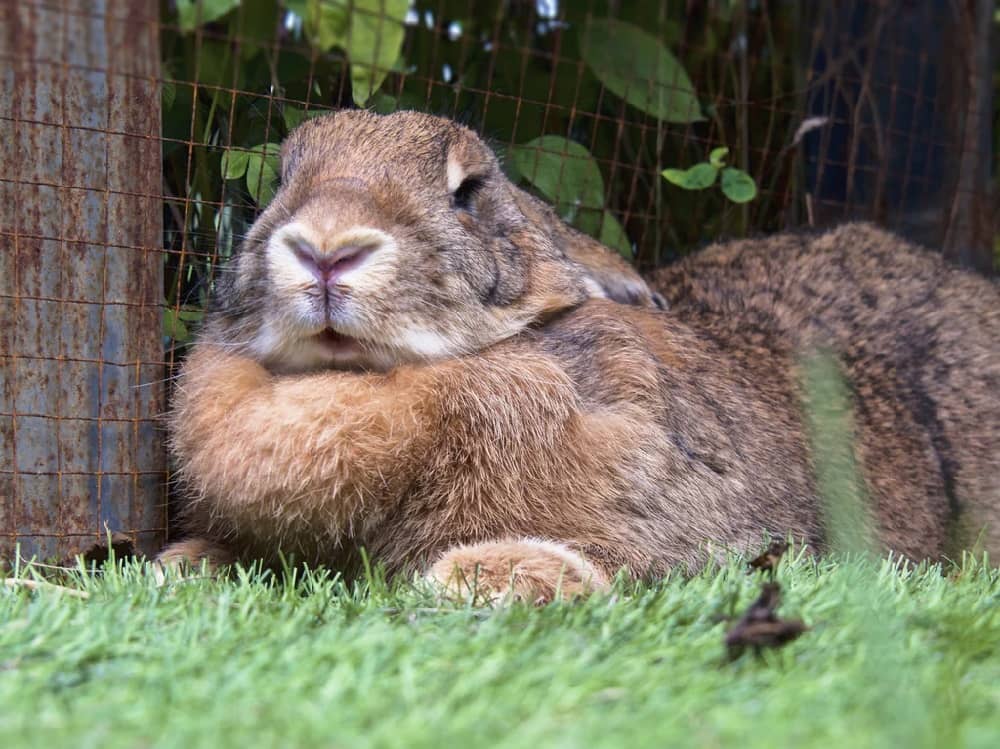
On the other hand, they may be more territorial, especially if they are not spayed. Spaying and neutering can help manage behavior and reduce the risk of certain health issues. The females attain sexual maturity at the age of 1 year. They have a dewlap, a thick, extra fur-coated skin to keep the bunnies warm.
How to Care for a Flemish Giant Rabbit?
To care for the Flemish Giant, you must provide a comfortable habitat, a well-nutritious diet, and a playful environment so that they are content.
Housing Requirements
Flemish lions are large and hence require spacious housing. These are preferred to be kept in homesteads where they can get enough space to run and explore.
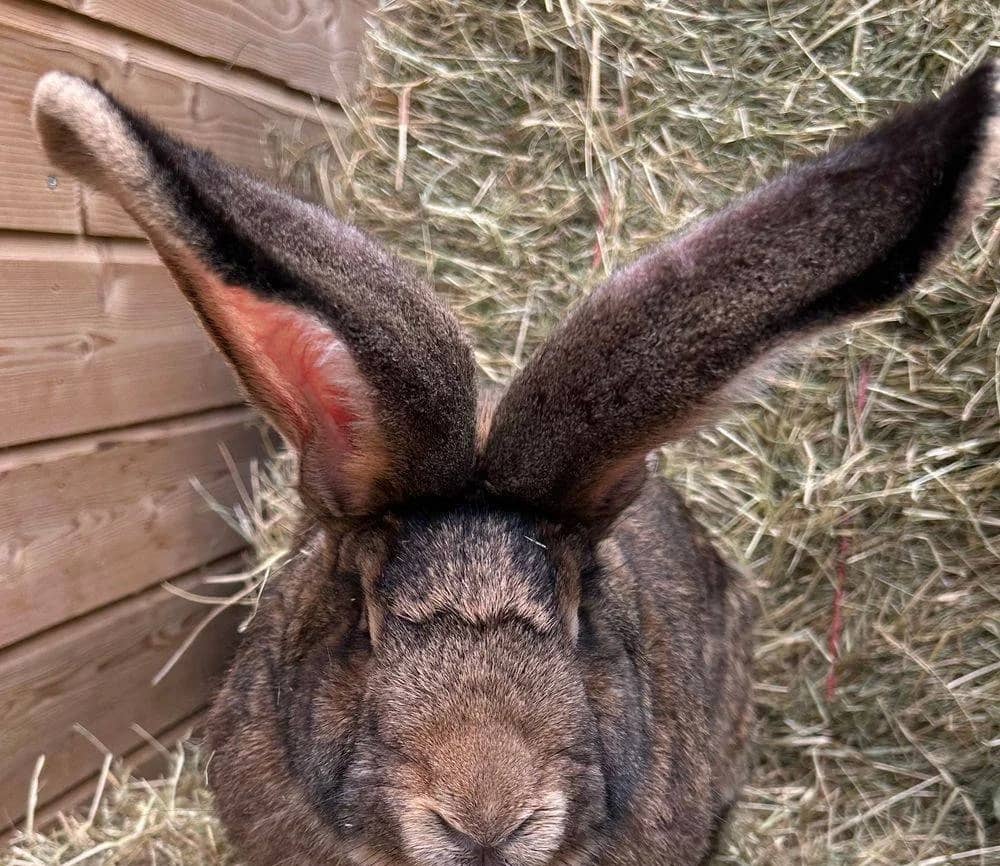
However, for indoor living, a large indoor rabbit cage or a specially designed hutch is essential. The enclosure should be at least 4 feet by 3 feet, but larger is always better. They also need a secure outdoor run or a rabbit-proofed area of the house to exercise. They can jump as high as 3 feet, so their enclosure should be tall.
Specific Substrate Needs
The substrate in their living area should be soft and absorbent to keep them comfortable and clean. Options include hay, straw, or recycled paper bedding. Regular cleaning is necessary to maintain hygiene and prevent health issues.
Food Bowl
A ceramic bowl can be kept inside its enclosure to serve vegetables and pellets.
Water Dish or Water Bottle
Some rabbits prefer to drink water from a shallow water dish so you should keep both a water dish and a water bottle to provide clean water.
Chew Toys
The rabbits have a natural instinct to chew, so you can provide some chew toys, such as untreated wood, apple chew sticks, and bamboo.
Food
Flemish giants are bigger in size, and hence their diet requirements are higher than those of a regular-sized rabbit. A balanced diet is crucial for the health of Flemish giant rabbits. Their diet should consist of the following:
- Hay: It is a staple of their diet, providing necessary fiber. It should be available in unlimited amounts to the Flemish giant. A general rule is that it consumes hay equivalent to its body size.
- Pellets: You should add high-quality rabbit pellets so as to provide essential nutrients in their diet. It should be given around ¼ cup to ½ cup of rabbit pellets to your rabbits.
- Fresh Vegetables: Leafy greens, carrots, and other safe veggies like bell peppers, celery, and spinach should be given to them.
- Fresh Water: You should always ensure that they have access to clean and fresh water.

Exercise
Due to their size, Flemish Giants need plenty of exercise to stay healthy. Daily access to a large, safe area to hop and play is essential. This helps prevent obesity and promotes mental stimulation.
Handling of Flemish Giant Rabbits
The Flemish giants are heavy, and handling them is not recommended if you are not committed to holding them gently. Therefore, when handling a Flemish giant, always support their hindquarters and back to prevent injury. You should lift them gently and hold them close to your body to make them feel secure. The rough handling can result in a change in behavior, such as biting or scratching.

Grooming
Flemish lions are low-maintenance but require regular grooming to keep their coats healthy. You can brush their fur weekly to prevent matting and shedding. Moreover, check their nails and trim them as needed.
Common Health Issues in Flemish Giant Rabbits
Obesity
Due to their large size, they are prone to weight gain. You should monitor the amount of diet it consumes per day. Moreover, the Flemish Giant should be given enough activities to keep it physically and mentally stimulated.
Dental Problems (Malocclusions)
Overgrown teeth can lead to serious health issues, and your bunny may find difficulty chewing. A diet with a high content of fiber and chew toys can help reduce excess growth.
GI stasis
It is a life-threatening condition where the digestive system slows down or stops. This may result from poor diet and lack of physical activity.
Sore Hocks
Sore hock, also known as pododermatitis, is a frequent condition that causes inflammation, sores, or ulcers on the undersides of the foot in Flemish Giant rabbits. The main causes of this ailment are the huge weight of these rabbits, rough or hard surfaces like the flooring of their wire cages, and inadequate hygiene.
Redness, swelling, and open sores are some of the symptoms that cause pain and a hesitancy to move. Keeping a healthy weight, utilizing soft, clean bedding, and keeping the living place dry and clean are all part of prevention. See a veterinarian if sores appear; treatment options may include antibiotics, painkillers, and foot protection. In order to prevent and treat sore hocks in Flemish Giants, routine observation and appropriate care are crucial.
Uterine Ulcers
Serious health issues, such as endometritis or uterine cancer, are frequently associated with uterine ulcers in Flemish giant rabbits. These ulcers can arise from persistent inflammation or infections of the uterus.
If left untreated, these ulcers can result in severe pain, unusual bleeding, and discharge, which can worsen the rabbit’s general health and even be fatal. Lethargy, a decrease in appetite, and an enlarged abdomen are possible symptoms.
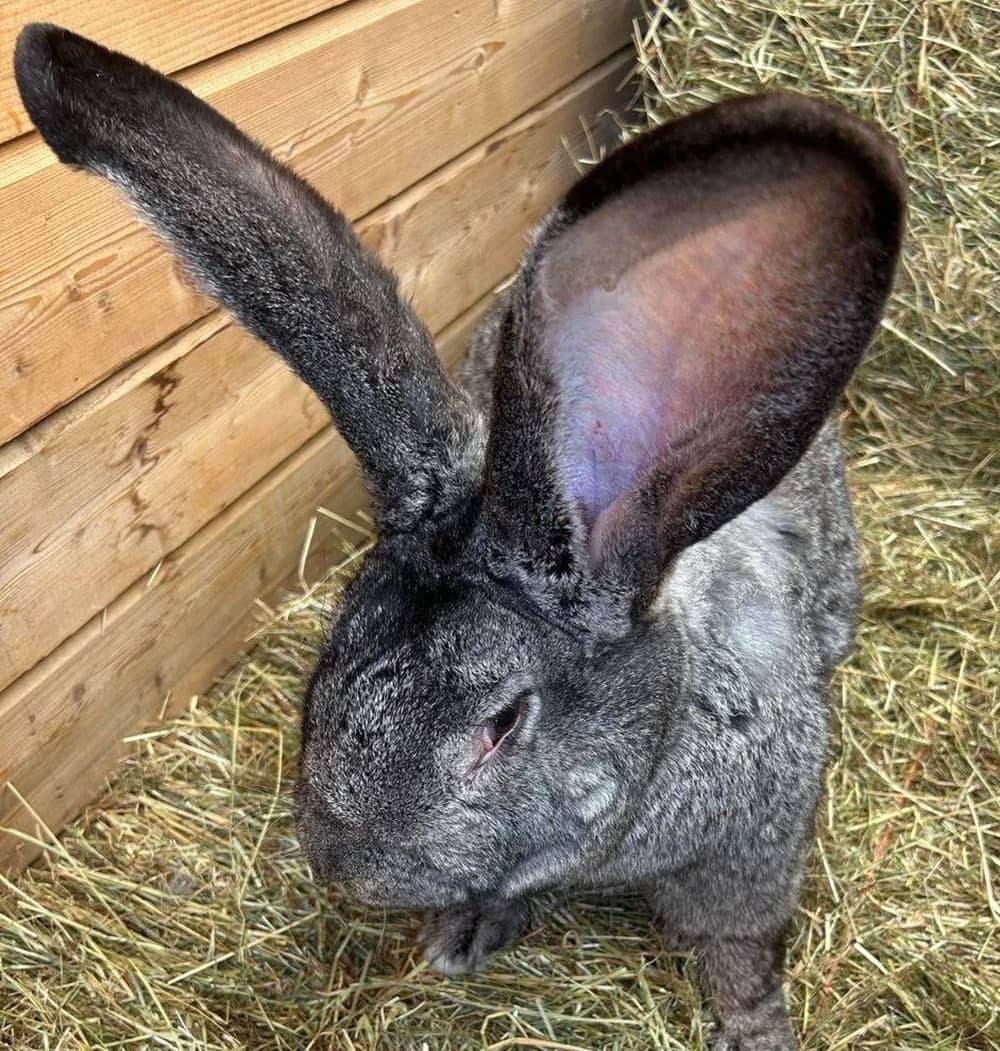
Frequent veterinary examinations and the possibility of spaying can reduce the incidence of uterine disorders, which is part of prevention and early detection. Early veterinarian intervention is essential for the identification and treatment of suspected uterine ulcers. Surgical alternatives, like spaying or antibiotics, may be used in this regard.
Arthritis
Because of their size, Flemish Giant rabbits are prone to arthritis, which can cause stiffness, pain in the joints, and decreased movement. Moving with difficulty, being reluctant to exercise, and obvious discomfort are symptoms. Weight control, creating a cozy living space, and veterinarian care—which could include painkillers and supplements to promote joint health—are all part of management. To successfully monitor and manage this illness, routine examinations are necessary.
Signs of Ill Health Include:
- Loss of appetite
- Lethargy
- Changes in stool consistency
- Dental issues like drooling or difficulty eating
Related Species
Flemish Giant rabbits are part of the domestic rabbit species, Oryctolagus cuniculus. Other large rabbit breeds include the Continental Giant and the Checkered Giant, but Flemish Giants are distinct in their gentle nature and impressive size.
- Belgian Hare
- Patagonian Rabbit
- Stone Rabbit
Where to Buy
Verified breeders, both locally and online, provide Flemish Giant rabbits for sale. You can start by looking through the classified listings on websites that sell and breed rabbits. Additionally, you can get in touch with breeders who could have Flemish Giants available by going to rabbit shows or contacting rabbit breed associations.
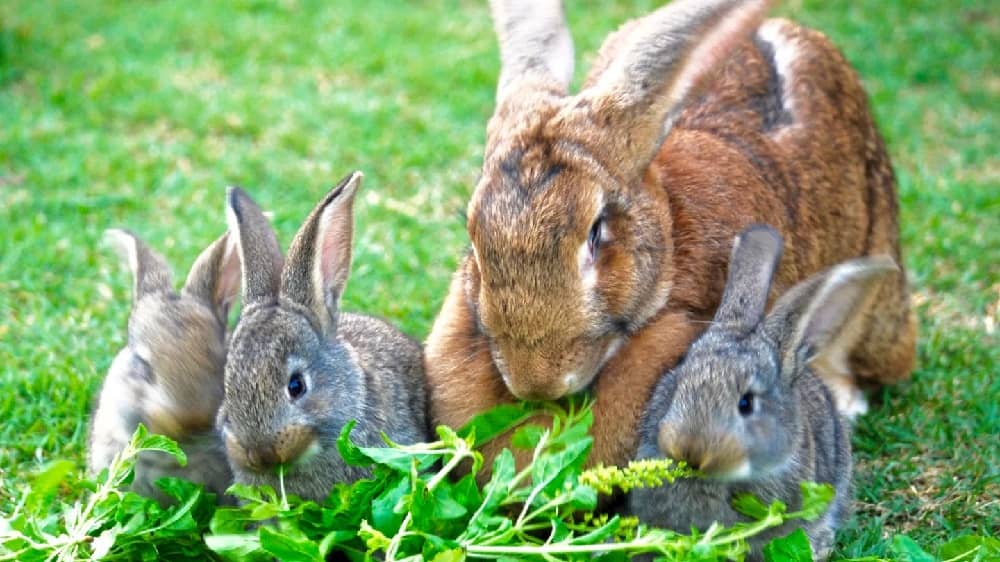
When buying a rabbit, make sure you do your homework on the breeder’s reputation and the rabbit’s medical history.
The cost of a flemish giant ranges between $50 and $300, depending on the quality of the breed.
Upkeep Cost
A Flemish Giant rabbit’s maintenance costs usually cover things like food, bedding, vet care, and sporadic grooming items. Compared to smaller breeds, Flemish Giants can have higher feeding expenses because they are one of the largest kinds of rabbits and need a lot of food to stay huge. You may have to spend around $40 to $60 per month on its food supplies.
Furthermore, because of their size, they might require larger cages or living areas, which could increase the initial setup costs to about $200 to $500.
Frequent veterinarian examinations are necessary to track their health, and unforeseen medical costs need to be included in the overall budget for maintenance. The annual check-up cost can be around $50–$100.
Even though grooming requirements are usually modest, occasionally grooming materials and nail cutting may be needed. The total cost of owning a Flemish Giant rabbit varies based on the region, level of care, and specific rabbit.
Reproduction and Breeding
Breeding Flemish Giants necessitates meticulous preparation and deep comprehension of rabbit care and genetics. A Flemish Giant doe usually gives birth to six to ten kits in each litter. Proper prenatal and postnatal care is mandatory for a healthy doe and her kits.
Interesting Facts About Flemish Giant Rabbits
- Flemish lions were originally bred for meat and fur.
- They are nicknamed “gentle giants” for their gentle nature and “Universal Rabbits” for their various purposes as pets, meat, show, and fur.
- They can live up to 8–10 years with proper care.
- The world’s largest rabbit is Darius, a Flemish giant rabbit that weighs around 49 pounds (22 kg) and measures 1.3 meters (4 feet and 3 inches).
- Despite their size, they are known for being gentle and friendly.
- They have a high food consumption rate due to their large size.
- Their ears are around eight inches long, and they can grow to be a whopping two and a half feet long.
- They are known as the “king of rabbits” due to their size.
- Seven color variants are recognized by the National Federation of Flemish Giant Rabbit Breeders: Black, Blue, Fawn, Light Gray, Steel Gray, Sandy, and White.
- Their calm demeanor makes them excellent therapy animals.
- Flemish Giants have a unique dewlap, a fold of skin under the chin. The dewlap, a broad flap of skin beneath the chin, is a feature of the female rabbit that she employs to protect her young.
- They require more frequent vet visits due to their size and potential health issues
- More than a century ago, in 1915, four Flemish Giant rabbit breeders established the Federation. This national federation promoted this breed.
- Bunnies are posed in certain ways at displays so judges can examine them.
- Like all other bunnies, flemish giants also eat their poops.
Frequently Asked Questions
Question 1: Do Flemish giant rabbits make good pets for children?
Answer: Yes, Flemish Giant rabbits are friendly, cute, and playful creatures, and keeping them as pets is quite rewarding. They coexist and are friendly with other pets as well.
Question 2: What are the common health issues in Flemish giant rabbits?
Answer:. Obesity, dental problems, and respiratory infections are some of the common health concerns in Flemish Giant rabbits.
Question 3: Can Flemish Giant rabbits be litter-trained?
Answer: It is possible to successfully litter-train Flemish Giant rabbits by using consistent training techniques and rewarding behavior.
Question 4: Can I keep a Flemish Giant rabbit outdoors?
Answer: While possible, indoor housing is safer due to predators and weather conditions. Moreover, they don’t catch bacterial infections
Question 5: Are Flemish Giant rabbits hard to take care of?
Answer: Flemish Giant Rabbits are low-maintenance creatures. But they need a well-balanced, nutritious diet and exercise. The habitat needs regular cleaning.
Question 6: How much do Flemish giant bunnies cost?
Answer:.They can cost around $50–$300, depending on age and breed.
Question 7: How long do Flemish Giant bunnies live?
Answer: In captivity, the lifespan of a Flemish Giant rabbit is around 8 to 10 years.
Question 8: Do Flemish Giant like to be held?
Answer: The Flemish giant rabbits are calm, incredibly affectionate, and love to snuggle in the arms of their owners. They are social and enjoy human interaction.
Question 9: How often should I clean my Flemish Giant rabbit’s cage?
Answer: You should spot-clean daily and perform a thorough cleaning weekly.
Question 10: Are Flemish giant rabbits lazy?
Answer: Yes, they love the peaceful environment and love to take naps in between.
